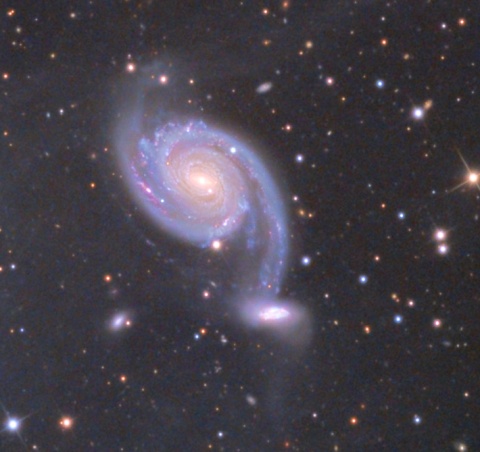
ARP 86
NGC 7752
Constellation: Pegasus
Right Ascension: 23h 46m 58.5s
Declination: +29º27′ 32”
Magnitude: 15.0
NGC 7753
Constellation: Pegasus
Right Ascension: 23h 47m 04.8s
Declination: +29º29′ 00”
Magnitude: 12.8
NGC 7752 and NGC 7753 are a set of galaxies approximately 272 million light-years away. Both were discovered by William Herschel on September 12, 1784.
NGC 7753 is the primary galaxy. It is a barred spiral galaxy with a small nucleus. NGC 7752 is the satellite galaxy of NGC 7753. It is a lenticular galaxy that is apparently attached to one of NGC 7753’sspiral arms, somewhat reminiscent to the famous M51 Whirlpool Galaxy.
In 1966, astronomer Halton Arp published a catalog of 338 galaxies entitled Atlas of Peculiar Galaxies.The main goal of the catalog was to present astro-photographs of many different kinds of peculiar structures of galaxies found among the various sky surveys. The reason why galaxies formed into spiral or elliptical shapes was not well understood, and he hoped that by publishing the atlas would stimulate the astronomy community into further study. He perceived peculiar galaxies as small “experiments” that astronomers could use to understand the physical processes that distort spiral or elliptical galaxies. With this atlas, astronomers had a focus group of peculiar galaxies that could be studied in detail. The atlas is a sampling of peculiar galaxies in the sky, each providing examples of the different phenomena as observed in galaxies.
One example of this stimulation of scientific inquiry is the following abstract written by Chandreye Sengupta, K.S. Dwarakanath, and D.J. Saikia of their study entitled “Hicontent and star formation in the interacting galaxy Arp86”:
“We present the results of Giant Metrewave Radio Telescope (GMRT) observations of the interacting system Arp86 in both neutral atomic hydrogen, Hi, and in radio continuum at 240 606 and 1394 MHz. In addition to Hi emission from the two dominant galaxies, NGC 7752 and NGC 7753, these observations show a complex distribution of Hi tails and bridges due to tidal interactions. The regions of highest column density appear related to the recent sites of intense star formation. Hi column densities ∼1–1.5 × 1021 cm−2have been detected in the tidal bridge which is bright in Spitzerimage as well. We also detect HI emission from the galaxy 2MASX J23470758+2926531, which is shown to be a part of this system. We discuss the possibility that this could be a tidal dwarf galaxy. The radio continuum observations show evidence of a non-thermal bridge between NGC 7752 and NGC 7753, and a radio source in the nuclear region of NGC 7753 consistent with it having a low-ionization nuclear emission region nucleus.”
NGC 7756 is the most likely member of Arp 86 to be seen by backyard telescopes at Magnitude 12.8. The fainter NGC 7752 is more likely picked up by astro-imagers than visually.